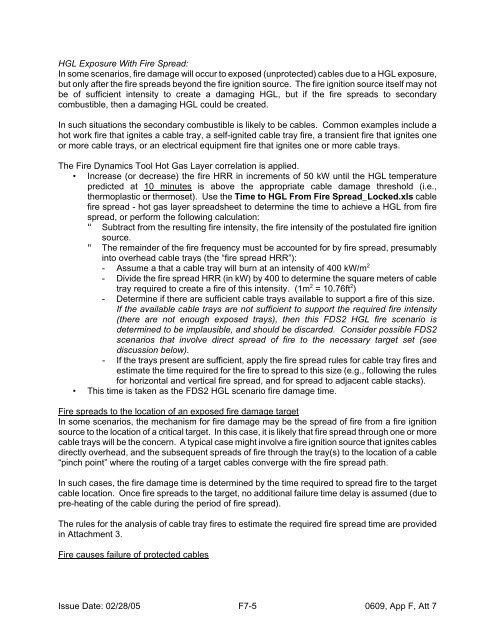IMC 0609, App F, Att 7 - NRC
IMC 0609, App F, Att 7 - NRC
IMC 0609, App F, Att 7 - NRC
Create successful ePaper yourself
Turn your PDF publications into a flip-book with our unique Google optimized e-Paper software.
HGL Exposure With Fire Spread:<br />
In some scenarios, fire damage will occur to exposed (unprotected) cables due to a HGL exposure,<br />
but only after the fire spreads beyond the fire ignition source. The fire ignition source itself may not<br />
be of sufficient intensity to create a damaging HGL, but if the fire spreads to secondary<br />
combustible, then a damaging HGL could be created.<br />
In such situations the secondary combustible is likely to be cables. Common examples include a<br />
hot work fire that ignites a cable tray, a self-ignited cable tray fire, a transient fire that ignites one<br />
or more cable trays, or an electrical equipment fire that ignites one or more cable trays.<br />
The Fire Dynamics Tool Hot Gas Layer correlation is applied.<br />
• Increase (or decrease) the fire HRR in increments of 50 kW until the HGL temperature<br />
predicted at 10 minutes is above the appropriate cable damage threshold (i.e.,<br />
thermoplastic or thermoset). Use the Time to HGL From Fire Spread_Locked.xls cable<br />
fire spread - hot gas layer spreadsheet to determine the time to achieve a HGL from fire<br />
spread, or perform the following calculation:<br />
" Subtract from the resulting fire intensity, the fire intensity of the postulated fire ignition<br />
source.<br />
" The remainder of the fire frequency must be accounted for by fire spread, presumably<br />
into overhead cable trays (the “fire spread HRR”):<br />
- Assume a that a cable tray will burn at an intensity of 400 kW/m 2<br />
- Divide the fire spread HRR (in kW) by 400 to determine the square meters of cable<br />
tray required to create a fire of this intensity. (1m 2 = 10.76ft 2 )<br />
- Determine if there are sufficient cable trays available to support a fire of this size.<br />
If the available cable trays are not sufficient to support the required fire intensity<br />
(there are not enough exposed trays), then this FDS2 HGL fire scenario is<br />
determined to be implausible, and should be discarded. Consider possible FDS2<br />
scenarios that involve direct spread of fire to the necessary target set (see<br />
discussion below).<br />
- If the trays present are sufficient, apply the fire spread rules for cable tray fires and<br />
estimate the time required for the fire to spread to this size (e.g., following the rules<br />
for horizontal and vertical fire spread, and for spread to adjacent cable stacks).<br />
• This time is taken as the FDS2 HGL scenario fire damage time.<br />
Fire spreads to the location of an exposed fire damage target<br />
In some scenarios, the mechanism for fire damage may be the spread of fire from a fire ignition<br />
source to the location of a critical target. In this case, it is likely that fire spread through one or more<br />
cable trays will be the concern. A typical case might involve a fire ignition source that ignites cables<br />
directly overhead, and the subsequent spreads of fire through the tray(s) to the location of a cable<br />
“pinch point” where the routing of a target cables converge with the fire spread path.<br />
In such cases, the fire damage time is determined by the time required to spread fire to the target<br />
cable location. Once fire spreads to the target, no additional failure time delay is assumed (due to<br />
pre-heating of the cable during the period of fire spread).<br />
The rules for the analysis of cable tray fires to estimate the required fire spread time are provided<br />
in <strong>Att</strong>achment 3.<br />
Fire causes failure of protected cables<br />
Issue Date: 02/28/05 F7-5<br />
<strong>0609</strong>, <strong>App</strong> F, <strong>Att</strong> 7
















